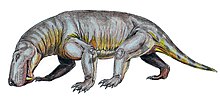Rubidgea
| Rubidgea Temporal range: Permian
| |
|---|---|

| |
| Skull of Rubidgea atrox | |
| Scientific classification | |
| Domain: | Eukaryota |
| Kingdom: | Animalia |
| Phylum: | Chordata |
| Clade: | Synapsida |
| Clade: | Therapsida |
| Clade: | †Gorgonopsia |
| Family: | †Gorgonopsidae |
| Tribe: | †Rubidgeini |
| Genus: | †Rubidgea |
| Type species | |
| Rubidgea atrox Broom, 1938
| |
| Synonyms | |
|
Genus-level
Species-level
| |
Rubidgea is an extinct genus of therapsids belonging to the Gorgonopsidae. It had very large canines functioning as saber-teeth, longer than the teeth of the dinosaur Tyrannosaurus rex.[1] It lived in the Permian period, specifically the Wuchiapingian stage. Rubidgea reached a length of 3.4 m (11 ft) and had a 46 cm (1.51 ft)-long skull.[2] Rubidgea was native to what is now South Africa, and based on its overall morphology, is considered to be the most robust and powerful of the gorgonopsids known. Though some of its relatives, such as the Russian Inostrancevia were as large or larger, they were far more slender in build when compared to Rubidgea.[3]
Classification

Below is a cladogram from the phylogenetic analysis of Gebauer (2007):[4]
See also
References
- ^ Blaire van Valkenburgh and Ian Jenkins (2002). "Evolutionary patterns in the history of Permo-Triassic and Cenozoic synapsid predators" (PDF). Paleontological Society Papers. 8: 267–289. Archived from the original (PDF) on 2013-10-17.
{{cite journal}}: Unknown parameter|deadurl=ignored (|url-status=suggested) (help) - ^ http://www.palaeocritti.com/by-group/gorgonopsia/rubidgea
- ^ Anton, Mauricio (2013). Sabertooth.
- ^ Gebauer, E.V.I. (2007). Phylogeny and evolution of the Gorgonopsia with a special reference to the skull and skeleton of GPIT/RE/7113 ('Aelurognathus?' parringtoni) (PDF) (Ph.D. thesis). Tübingen: Eberhard-Karls Universität Tübingen. pp. 1–316.

